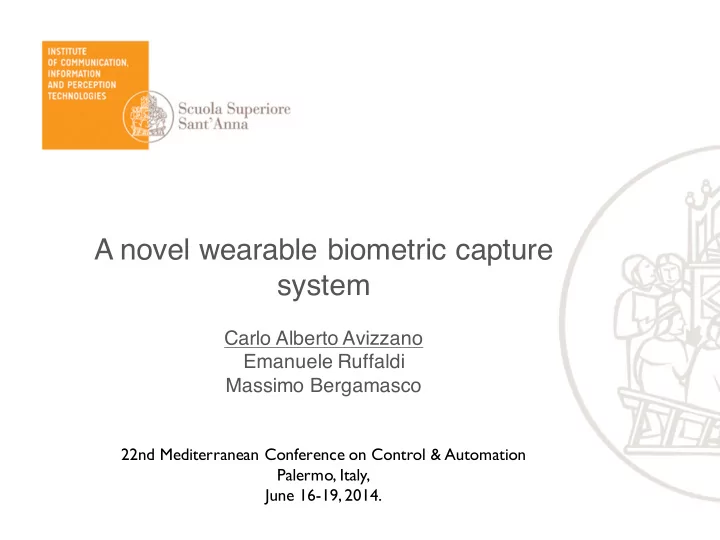

A novel wearable biometric capture system Carlo Alberto Avizzano Emanuele Ruffaldi Massimo Bergamasco 22nd Mediterranean Conference on Control & Automation Palermo, Italy, June 16-19, 2014.
Sports Motivation activities Applications areas Skills Body rehabilitation Transfer Application areas: Wearable disease prevention haptics work Ergane Project analysis A novel wearable biometric capture system
Pre existing multichannel wireless EMG boards (No available solution)
Previous work assess scenario: Imu + gTEC • No sync with IMUs • Electric anchor Limitations: • Reduced number of EMG channels • Post process analysis • Non realtime or interactive applications • Not embeddable or portable to dynamic environment/scenarios
Applications requirements Integrated posture Combined reconstruction Networked with body access and motion control capture Onboard Realtime filtering and interaction processing and streaming Human Fully wearable Several EMG biometric and Self signals powered assessment A novel wearable biometric capture system
Design Goal • A novel biometric capture system (BCS) for capture and analysis of motion and EMG signals. • The system is composed of: • An embedded wearable device • A modular server A novel wearable biometric capture system
Acquisition board architecture Dimensions: 5 inches mobile phone • Processor: STM32F407 (168MHz) • Nine-axis inertial sensors: 4 (mpu9150) • EMG: 32 channels (ADS1298) • Bluetooth (HiSpeed UART transceiver) • A novel wearable biometric capture system
Acquisition architecture
Computing architecture • EMG interface: 32 channels @ 4KHz • Internal software filter allow to manage the EMG information accordingly to the • IMU: 100 Hz constant rate (I2C) common practice in bio-medical application • Shared Timestamp for data alignment • When possible communication is done through DMA A novel wearable biometric capture system
The featuring subsystem • The device provides the parallel computation of a wide set of features that can be broadcasted at lower frequencies: • Mean Square • Average Rectified Value • Number of Zero Crossing • Number of Peaks A novel wearable biometric capture system
The server software architecture • The web server serves the incoming Bluetooth connection, decode the data into several streams and make them available as websocket services • Supports real-time file recording of the received data • The host server support loading at startup for external plugins. A novel wearable biometric capture system
The web server interface The webserver uses Completely interoperable data sharing standards and visualization such as among different Oses (OSX, Linux, Android, Websockets, WebGL, iOS, Windows) jQuery and dygraphs JS library (dygraphs.com) The device provides a Access and control all variety of additional information (rapid plots data in the board Save and recall experiments. and access to plugin architecture) IMUs (3D information about linear acceleration, EMG channels. angular velocities and Earth magnetic field) A novel wearable biometric capture system
External plugin interface plugins architecture Initialized through a configuration file with a specific syntax. Load execute external libs with shared data Define server VS external lib I/O relationships (a lightweight data sharing environment). Plugins for Matlab- Simulink can connect to the serve in external mode Simulink RTW target: Simulink can be used to generate standalone models compatible with the server Any sort of filter to further expand the system capabilities with higher level functionalities plugins may interact: skeleton reconstruction, muscular activity, force analysis, complementary or Kalman filters, sensors calibrations, … A novel wearable biometric capture system
Performance assessment • The performance of the system are limited by three concurrent factors: 1. the internal capabilities of the embedded acquisition board 2. the bandwidth limitation of the wireless communication link 3. the local capabilities of the server host. • The processor load is close to 85% with all services running • We use a recent Bluetooth module which can support transfers up to 760Kbit/s. A novel wearable biometric capture system
Integrated system
Conclusions • We discusses the software architecture and the characteristics of a novel wireless biometric system that aims at providing integrated force and motion capabilities. • The system is capable of acquiring, filtering and processing: • 32 channenls EMG signals (4 KHz) • 4 IMUs signals (100 Hz) • The system can be interfaced with a server which exposes a web interface and a plugin architecture to expand system capabilities • The system is currently being tested in e variety of sectors: • Assessment of work injuries performed in ecological conditions [7]. • Assessing rowers technical capability in indoor and outdoor conditions [8]. A novel wearable biometric capture system
thank you! email: c.avizzano@sssup.it
References [1] M. E. Cassinelli and P . O’Connor, NIOSH manual of analytical methods. National Institute for Occupational Safety and Health, 1994. [2] L. Gonzalez-Villanueva, S. Cagnoni, and L. Ascari, “Design of a wearable sensing system for human motion monitoring in physical rehabilitation,” Sensors, vol. 13, no. 6, pp. 7735–7755, 2013. [3] Windolf, Markus, Nils Götzen, and Michael Morlock. "Systematic accuracy and precision analysis of video motion capturing systems—exemplified on the< i> Vicon-460</i> system." Journal of biomechanics 41.12 (2008): 2776-2780. [4] S. Shahid, J. Walker, G. M. Lyons, C. A. Byrne, and A. V . Nene, “Application of higher order statistics techniques to emg signals to characterize the motor unit action potential,” Biomedical Engineering, IEEE T ransactions on, vol. 52, no. 7, pp. 1195–1209, 2005 [5] A. Burns, B. R. Greene, M. J. McGrath, T . J. O’Shea, B. Kuris, S. M. Ayer, F . Stroiescu, and V . Cionca, “Shimmer–a wireless sensor platform for non invasive biomedical research,” Sensors Journal, IEEE, vol. 10, no. 9, pp. 1527–1534, 2010. [6] J. D. Hol, “Sensor fusion and calibration using inertial sensors, vision, ultra-wideband and gps,” Ph.D. dissertation, Linkoping, 2011. [7] L. Peppoloni, F . Alessandro, and R. Emanuele, “Assessment of task ergonomics with an upper limb wearable device,” in IEEE Mediterranean Conference on Control and Automation, MED, 2014. [8] A. Filippeschi and E. Ruffaldi, “Boat dynamics and force rendering models for the sprint system,” Human-Machine Systems, IEEE T ransactions on, vol. 43, no. 6, pp. 631–642, 2013. A novel wearable biometric capture system
Recommend
More recommend